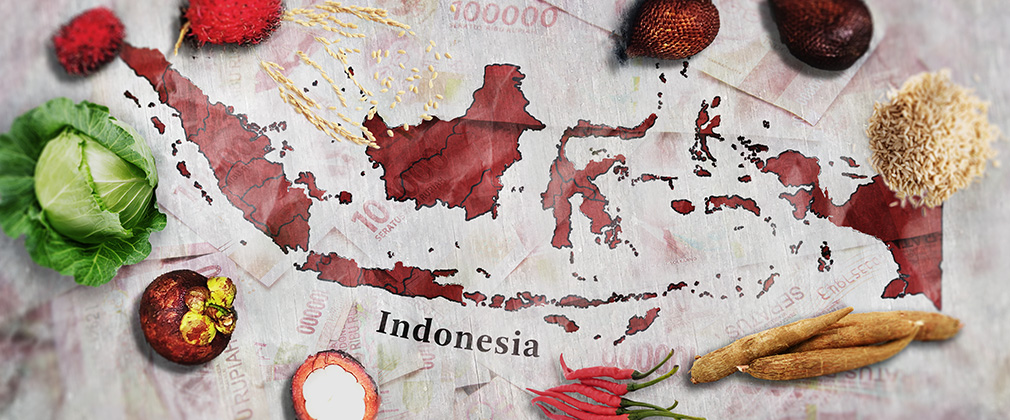Meeting Climate, Health and Economic Goals Requires Food Systems Transformation
Sep 15, 2021

To ensure adequate nutrition and food security, and prevent the worst climate change scenarios, food systems must transform to provide affordable, healthy diets from sustainably produced foods. However, optimizing diets to meet all of these goals simultaneously remains a challenge. This is according to a new case study on Indonesia by researchers at The Johns Hopkins Center for a Livable Future (CLF) in collaboration with the UN World Food Programme, the Johns Hopkins Berman Institute of Bioethics, Bogor Agricultural University, and YARSI University (Jakarta).
The full study is published online in The American Journal of Clinical Nutrition.
Indonesia is one of many middle-income countries affected by the “triple burden of malnutrition,” which is described as the co-existence of micronutrient deficiencies, undernutrition and overweight/obesity. The current diet in Indonesia relies heavily on rice as the primary dietary staple, which means the diet has low diversity, insufficient amounts of fruits, vegetables and animal source foods and inadequate nutrient content, researchers found. Climate change will likely further exacerbate prevalence of micronutrient deficiencies, not only through water shortages, loss of crops, lower yields and loss of livelihoods, but also by reducing the nutritional values of foods; vitamin B content in rice is one such example.
For their study, researchers assessed the Indonesian diet compared with 13 dietary scenarios that were optimized to meet a combination of health, nutrition, environment, and/or cost goals. A key finding of the study was that no single dietary scenario met all the criteria for achieving a sustainable, affordable and nutritious diet.
“We need more and better tools that can help researchers assess how to optimize diets according to their environmental, nutrition, health and affordability impacts, while also taking feasibility of production and food preferences into account” said lead author Saskia de Pee, PhD, from the UN World Food Programme. “Making decisions about managing trade-offs so that the highest number of people can eat nutritious, affordable, tasty and sustainably produced diets will require well-informed, high-level multi-sectoral government commitment.”
The study also highlights the tradeoffs needed for meeting critical nutrient needs at the lowest possible cost while also lowering greenhouse gas emissions to meet the 2050 target set forth by the EAT-Lancet Commission.
“Our research indicates there is no one-size-fits-all scenario, especially when dealing with middle-income countries undergoing transitions,” says senior author, Martin Bloem, MD, PhD, Director of the CLF and the Robert S. Lawrence Professor of Environmental Health at the Bloomberg School. “We must pay attention to the different needs that children, women, and men have across their life cycles, and we must advise changes that are in keeping not only with the life cycle needs, but also with the cultural preferences of the people for whom we’re recommending changes.”
To combat malnutrition, the authors recommend prioritizing the prevention of undernutrition by first meeting nutrient needs and aiming for diets to become increasingly diversified and nutrient-dense. The authors also emphasize the importance of making changes to food production and trade to increase the supply and diversity of nutritious and healthy foods at a lower environmental cost.
The affordability of foods is another major challenge for achieving the level of food diversity needed for healthy diets, while also, ideally, not increasing or even decreasing their environmental footprint. COVID-19 has markedly reduced the income of the average Indonesian, and researchers recommend that dietary change should mostly occur without needing to increase food expenditure.
“In an ideal scenario, all Indonesians will be able to afford and access foods that are nutritious and appealing, and that also have the lowest carbon footprint possible,” says co-author Hardinsyah, PhD, President of the Food and Nutrition Society of Indonesia and former Dean of Human Ecology Faculty at Bogor Agricultural University. “But when all those things are not immediately possible, we must make decisions about what the priorities are.”
The type of food system transformation needed in Indonesia—and around the world—requires that governments prioritize diversity in food production and consumption. The more, different types of foods are carefully produced and eaten, the closer we’ll come to achieving that necessary transformation. With a food system that produces a wider range of fruits, vegetables, pulses, nuts and grains, and moderates the quantity of more sustainably produced animal source foods, movement toward more climate-friendly agriculture becomes possible.
The study was funded by the Greater Kansas City Community Foundation.
“Balancing a sustained pursuit of nutrition, health, affordability and climate goals: Exploring the case of Indonesia” was written by De Pee S, Hardinsyah, Jalal F, Kim BF, Semba RD, Deptford A, Fanzo JC, Ramsing R, Nachman KE, McKenzie S, Bloem MW.